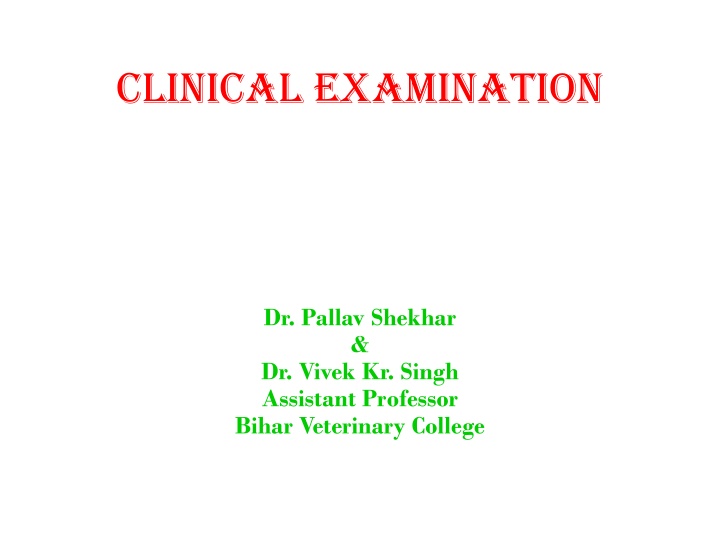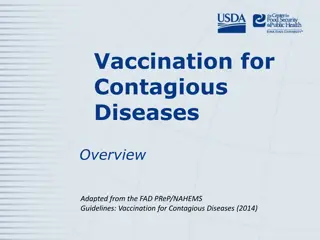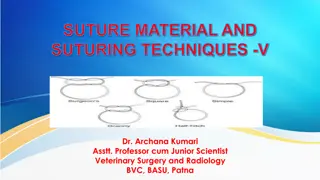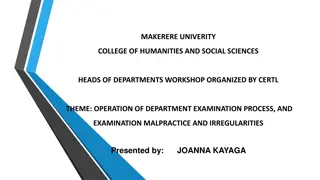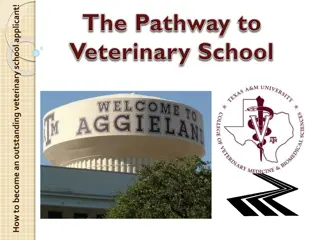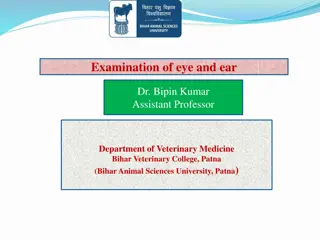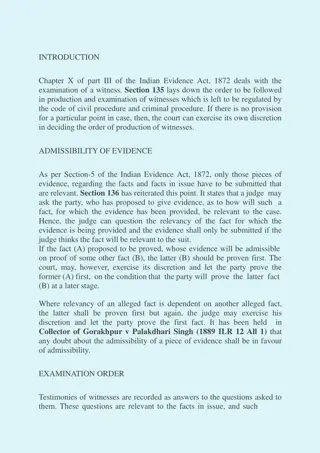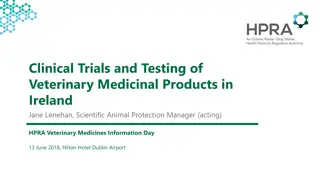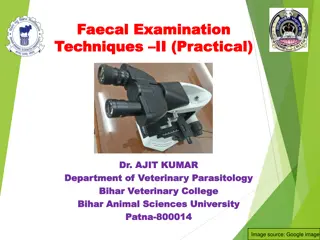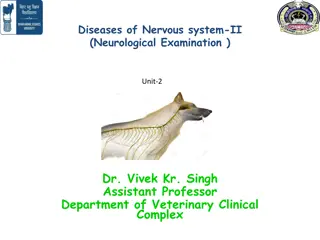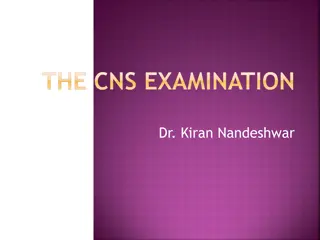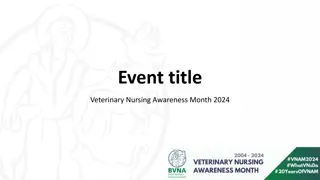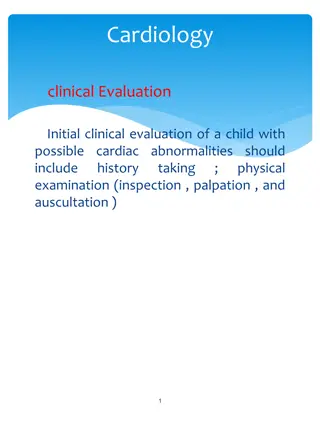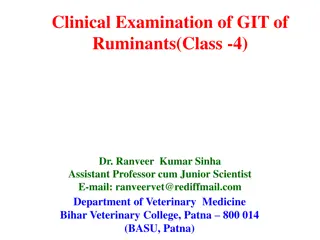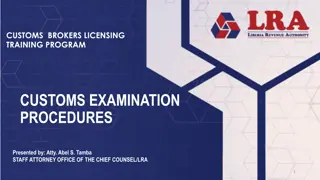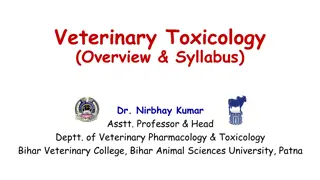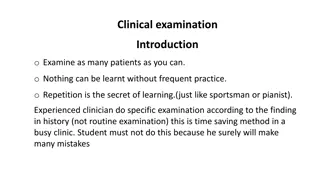Veterinary Clinical Examination Techniques and Procedures
Learn about the essential veterinary clinical examination techniques including distant examination (inspection), physical examination (palpation, percussion), auscultation, and more. Understand the importance of visual observation, hands-on assessment, and listening to internal organ sounds in diagnosing and assessing animal health. Enhance your skills in identifying signs of illness and abnormalities through these thorough examination methods.
Download Presentation

Please find below an Image/Link to download the presentation.
The content on the website is provided AS IS for your information and personal use only. It may not be sold, licensed, or shared on other websites without obtaining consent from the author.If you encounter any issues during the download, it is possible that the publisher has removed the file from their server.
You are allowed to download the files provided on this website for personal or commercial use, subject to the condition that they are used lawfully. All files are the property of their respective owners.
The content on the website is provided AS IS for your information and personal use only. It may not be sold, licensed, or shared on other websites without obtaining consent from the author.
E N D
Presentation Transcript
Clinical Examination Dr. Pallav Shekhar & Dr. Vivek Kr. Singh Assistant Professor Bihar Veterinary College
Clinical Examination Distant Examination Physical Examination
Distant Examination (INSPECTION) It means visual examination of the patient from a distance It includes examination of Behavior and general appearance Behavior is a reflection of the animal s health Separation of an animal from its group is often an indication of illness
PHYSICAL EXAMINATION PALPATION Palpation is an act of handling tissues, organs or parts of animal body. It is a close physical examination
Types of palpation Direct palpation: with the finger Indirect palpation : with a probe PERCUSSION Percussion is an act performed by striking or tapping a part of the body. In percussion, the body surface is struck so as to set deep parts in vibration and cause to emit audible sounds.
Direct or immediate :Performed with the fingers using one hand as a plexor/ percussion hammer and other as a pleximeter Indirect or mediate: percussion hammer on a pleximeter disk in large animals performed using
Ballottement: Ballottement is a technique used to detect floating viscera or masses in the abdominal cavity. Using the extended fingers or the clenched fist the abdominal wall is palpated vigorously with a firm push to move the organ or masses away and then allow it to rebound on to the fingertips Ballottement / Tactile percussion = Palpation + Percussion
AUSCULTATION Auscultation: It is a method of listening to the functional sounds produced by internal organs It is routinely used to assess heart sounds, lung sounds and gastrointestinal sounds
Direct Auscultation : Direct listening to the sounds produced by organ movement. It is performed by placing the ear to the body surface over the organ Indirect Auscultation : Indirect auscultation is performed with the aid of stethoscope or phonendoscope. It is the preferred technique
Parts of a stethoscope: Chest piece with diaphragm Connecting/conducting tube Ear pieces(2)
Succussion This is also a combined method of physical examination where shaking of body from side to side and simultaneous auscultation are done to detect the presence of fluid
RECORDING OF BODY TEMPERATURE Short bulb clinical thermometer As a general rule the thermometer should be left in place for 2 minutes Hyperthermia is simple elevation of the temperature past the critical point, as in heat stroke. Fever or pyrexia is the state where Hyperthermia is combined with toxaemia, as in most infectious diseases
Hypothermia, a subnormal body temperature, occur in shock, Circulatory collapse(as in parturient paresis impaction of cattle), hypothyroidism and just before death in most diseases and acute rumen
Species Normal temperature 36.6 C(99.5 F) Critical point Horse 39.0 C(102.0 F) Cattle 38.5 C(101 F) 39 C(103.0 F) Calf up to 1 year 39.2 C(102.5 F) Pig 39.0 C(102.0 F) 40.0 C(103.5 F) Sheep 39.0 C(102.0 F) 40.0 C(104.0 F) Goat 39.5 C(103.0 F) 40.0 C(105.0 F) Poultry 41.6 C(106.0 F) Dog 38.5 C(101.5 F) Cat 38.5 C(101.5 F) Foal 38 C(100.5 F)
RECORDING OF PULSE RATE Pulse is the expansion and elongation of the arterial wall imparted by the column of arterial wall due to contraction of left ventricle
Species Site Cattle, buffalo Middle coccygeal or facial arteries Horse External maxillary artery transverse facial artery Femoral artery Sheep and goat Dog Femoral artery Cat Femoral artery Pig(small) Femoral artery Pig(large) Middle coccygeal
Jugular pulse: Pulsation of jugular vein is known as jugular pulse. It is observed in the case of traumatic pericarditis in competence of tricuspid valve
Species Pulse rate/ min Adult horse 30-40 Foals up to 1yr 70-80 Adult cattle 60-80 Young calves 100-120 Sheep and goat 70-90 Pig(young) 60-90 Pig(large) 80-120 Dog(large) 70-90 Dog(small) 90-120 Cat 100-130 Fowl 130-160 Camel 32-50 Elephant 20-30
RECORDING OF RESPIRATORY RATE Respiration: It is the inhalation & exhalation of air from the lung. The respiratory mechanism is governed by respiratory centre & the centre is located in the medulla oblongata
Type of respiration Thoracic respiration: Thoracic muscles are predominantly involved in the process of respiration, observed in dogs & cats Thoraco-lumbar/abdominal Thoracic & abdominal muscle are equally in respiration & observed in horses, mule, donkey etc Abdominal respiration: Abdominal muscles are predominantly involved & are observed in cattle, buffalo, sheep & goat respiration: Both
Species Respiration Species Respiration rate /minute 8-14 rate /minute 18-30 Adult horses Sheep & goat Foals 14-16 Pig 16-18 Adult cattle 16-22 Dog 14-30 Young calves 27-30 Cat 20-30 Buffalo 22-28 Fowl 15-30
Prolongation of inspiration is usually due to obstruction of upper respiratory tract Prolongation of the expiration is often due to failure of normal lung collapse, as in emphysema (Lower respiratory track)
Examination of Mucous Membrane Yellow mucous membrane- Jaundice Pale and watery- anaemia Pale and dry- shock Brick red- arsenic poisoning Bluish mucosa- cyanosis
